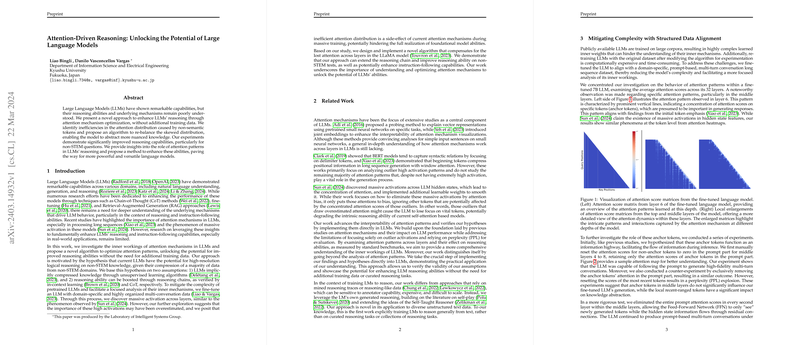Enhancing Reasoning in LLMs via Attention Mechanism Optimization
The paper "Attention-Driven Reasoning: Unlocking the Potential of LLMs" explores the latent reasoning capabilities of LLMs and presents an innovative method for enhancing these abilities through attention mechanism optimization. While LLMs such as GPT have exhibited significant proficiency across various domains, their reasoning mechanisms remain somewhat opaque. This paper proposes a method that optimizes the internal attention processes of LLMs without requiring additional training data, thereby augmenting the models' capacity to manage non-STEM reasoning tasks effectively.
Core Contributions
The central thesis of the paper revolves around identifying inefficiencies in the attention distribution of LLMs. These inefficiencies, often caused by high-frequency, non-semantic tokens that skew attention distribution, are hypothesized as a byproduct of the training paradigms used in next token prediction. The researchers postulate that adjusting this distribution can improve reasoning performance by leveraging long-range and nuanced knowledge representations.
The authors introduce an algorithm that implements a top-layer attention pattern for the downstream layers. This algorithm is designed to re-balance the attention focus without additional training steps, facilitating the capture of subtle information inherent in the data. The method capitalizes on contrasting the typically rich attention patterns from the top layers with those in the middle layers, which are prone to skews due to high-activity non-semantic tokens.
Experimental Validation and Results
Experiments conducted to validate this approach were performed using the LLaMA models and the MMLU benchmark. Outcomes indicated a significant improvement in handling non-STEM queries when applying zero-shot Chain-of-Thought (CoT) reasoning tests; large models demonstrated a pronounced benefit from the refined attention mechanism. Specifically, the modified LLaMA models showcased an increased average proportion of uniquely solved questions in certain categories compared to the non-modified versions. These results underscore the method's efficacy in extending more logical reasoning paths, akin to prompting strategies such as CoT, subsequently enabling more accurate responses.
Theoretical and Practical Implications
The enhanced reasoning capabilities of LLMs, as suggested by this paper, offer various implications for both theoretical exploration and practical application. On the theoretical side, the proposed approach sheds light on the role of attention mechanisms in cognitive processing within LLMs, paving the way for further research into fine-tuning these computational processes. Practically, these insights might guide the development of more robust language technologies tailored for applications requiring intricate reasoning, such as legal analysis, strategic decision-making, or complex problem-solving domains.
Future Directions
Despite the promising outcomes, the authors acknowledge the limitations tied to the approach, including a reduction in accuracy for cases solvable through early answering, hinting at a potential disruption of memorized knowledge circuits. Future research may focus on integrating this attention optimization approach with retraining phases to preserve the strengths of memory-resolved solutions. Additionally, exploring methods to reduce the computational and memory overhead introduced by maintaining top-layer attention patterns remains a prospective area for further streamlining model efficiency.
In conclusion, the paper provides a substantial contribution to the field of cognitive enhancement in LLMs, proposing a novel approach to improve reasoning abilities simply through attention optimization. This framework not only augments contemporary LLM capabilities but also inspires new trajectories in AI research focused on leveraging the innate potential of attention mechanisms to enable complex descriptions and analyses.
